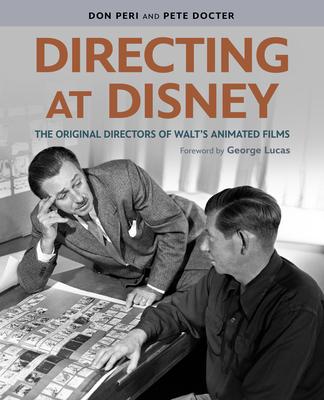
Book
Directing at Disney: The Original Directors of Walt's Animated Films
by Don Peri & Pete Docter
(Write a Review)
Hardcover
$50.00
When the very first animated films appeared, there were no directors. With no actors, sets, costumes, or sound, what appeared onscreen was simply decided and drawn by an animator. Since early films were usually made by only one or two artists, there was little need for planning. Organization was loose. When Walt Disney started animating on shorts and advertising projects in Kansas City, Missouri, he followed that process, along with fellow artist and friend Ub Iwerks.
Walt found that his strength was in story and character. He began writing outlines, describing what would appear scene by scene. Soon the text was accompanied by a sketch previsualizing the layout, giving all animators working on a film a clear vision of how their parts fit into the whole. Ultimately, Walt shepherded stories from their inception through every revision and gag. He approved every camera angle. He dictated what happened in every shot, sometimes every frame, obsessing over every detail. While not credited as such onscreen, Walt was the first Disney director.
As the Disney studio grew, Walt organically evolved the role of director, reflecting the amount of trust he had in those he worked with, his interest in a specific project, and what other projects he had on his plate. Walt expected his directors to follow his instructions--and to improve the work at every turn. Directing at Disney: The Original Directors of Walt's Animated Films offers the little-known history behind Walt's foundational directors, such as Wilfred Jackson, Clyde Geronimi, and Dave Hand. These talents directed some of the most beloved films in existence--Snow White and Seven Dwarfs, Pinocchio, Peter Pan, and One Hundred and One Dalmatians--yet virtually no one has heard of them . . . until now.
When the very first animated films appeared, there were no directors. With no actors, sets, costumes, or sound, what appeared onscreen was simply decided and drawn by an animator. Since early films were usually made by only one or two artists, there was little need for planning. Organization was loose. When Walt Disney started animating on shorts and advertising projects in Kansas City, Missouri, he followed that process, along with fellow artist and friend Ub Iwerks.
Walt found that his strength was in story and character. He began writing outlines, describing what would appear scene by scene. Soon the text was accompanied by a sketch previsualizing the layout, giving all animators working on a film a clear vision of how their parts fit into the whole. Ultimately, Walt shepherded stories from their inception through every revision and gag. He approved every camera angle. He dictated what happened in every shot, sometimes every frame, obsessing over every detail. While not credited as such onscreen, Walt was the first Disney director.
As the Disney studio grew, Walt organically evolved the role of director, reflecting the amount of trust he had in those he worked with, his interest in a specific project, and what other projects he had on his plate. Walt expected his directors to follow his instructions--and to improve the work at every turn. Directing at Disney: The Original Directors of Walt's Animated Films offers the little-known history behind Walt's foundational directors, such as Wilfred Jackson, Clyde Geronimi, and Dave Hand. These talents directed some of the most beloved films in existence--Snow White and Seven Dwarfs, Pinocchio, Peter Pan, and One Hundred and One Dalmatians--yet virtually no one has heard of them . . . until now.
Hardcover
$50.00